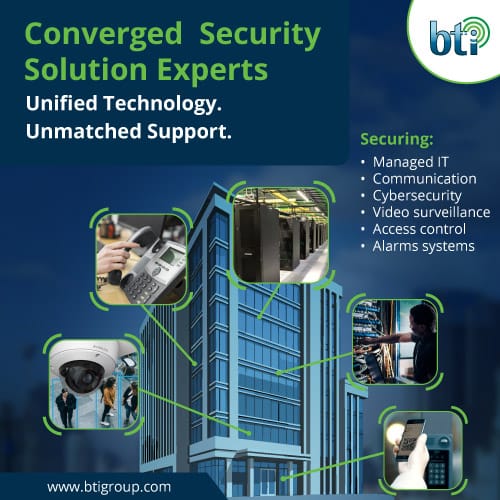In security, precision matters—especially when it comes to emergency alert systems. Confusing a panic button with a duress button might not seem like a big deal—until it’s too late.
At BTI Communications Group, we help organizations across manufacturing, logistics, healthcare, education, and government sectors integrate advanced physical security and IT solutions tailored to their operational realities. That includes selecting and deploying the right emergency notification technology—because one button could mean the difference between immediate lockdown and silent alarm.
If you’re evaluating security upgrades and are wondering what exactly sets panic buttons apart from duress buttons (and why that distinction matters), you’re in the right place.
What Is a Panic Button?
A panic button is a device used to trigger an immediate alarm or emergency response. It’s typically overt and intended to alert security personnel or first responders of a dangerous situation in progress—think armed robbery, physical assault, or other visible threats.
Typical Features:
- Audible alarms
- Visible notifications
- Optional integration with strobe lights or intercoms
- Often hardwired into the facility’s access control system
Best For:
- Retail stores
- Banks and credit unions
- Reception areas
- Entry control points
BTI-Compatible Panic Button Solutions:
- Integrated alarm panels tied to intrusion detection
- Configurable public alerts and emergency broadcast integrations
- System triggers connected to door access events and alert protocols
What is a Duress Button
A duress button serves a different, more discreet purpose. It’s used when a person is under direct threat but cannot safely raise an obvious alarm. These devices are designed to silently alert security without tipping off the assailant.
- Integrated access control platforms with silent activation capabilities
- Smart reader credentials that signal distress discreetly
- Mobile panic features tied to personnel location and job function
- Wearable panic buttons that clip to clothing, ID badges, or lanyards—ideal for healthcare workers, educators, or lone staff members in high-risk zones
What is the Difference Between a Panic Button and a Duress Button?
| Feature | Panic Button | Duress Button |
|---|---|---|
| Alert Type | Audible/Visible | Silent/Hidden |
| User Visibility | Public (e.g, under the desk, wall) | Private (e.g., under desk, app) |
| Purpose | Alert others of active threat | Secret request for help |
| Integration | Alarms, public alerts. | Access control, silent alerts |
| Ideal Scenario | Over emergency | Covert, under-threat situation |
How BTI Designs Emergency Systems That Work?
No two environments are the same. BTI designs layered emergency systems that incorporate panic and duress functionality into:
- Access Control Systems (Software House, OpenPath, Kantech)
- Alarm and Intrusion Detection Systems (DSC, DMP, Alarm.com)
- Mobile and Cloud Platforms for remote emergency response management
- Wired and Wireless Button Deployments for new construction and retrofitted facilities alike
- Wearables for On-the-Move Workers such as nurses, teachers, or security officers who need discreet, accessible alerts from anywhere on-site
Building-Wide Lockdown Capability
In high-risk situations where an immediate threat demands swift action, BTI can deploy one-touch lockdown buttons that instantly secure the facility. These are mounted in strategic locations and are engineered to initiate building-wide lockdowns with a single press—securing doors, alerting responders, and activating audio-visual alarms if required.
These buttons are designed with protective covers to prevent accidental activation and integrate directly with access control and alarm systems. For schools, healthcare facilities, warehouses, and multi-tenant buildings, they provide a critical layer of protection during active threat scenarios.
Combined with real-time monitoring and remote override capabilities, this feature ensures that your emergency protocols aren’t just theoretical—they’re actionable, immediate, and reliable when it matters most.
Compliance & Workplace Safety
In industries like healthcare, education, and logistics, the stakes are high. Emergency response solutions aren’t just a nice-to-have—they’re a matter of regulatory and operational necessity.
BTI helps organizations meet or exceed compliance standards tied to:
- OSHA workplace safety for violence prevention and emergency preparedness
HIPAA security protocols for hospitals and healthcare providers
TAPA and CTPAT standards for logistics and supply chain security - State and federal active shooter preparedness requirements
Our systems reduce liability and improve audit readiness by integrating panic, duress, and lockdown capabilities with access logs, time-stamped reporting, and automated alerts.
For healthcare facilities, BTI frequently installs these systems to protect staff from disgruntled patients, workplace violence, or escalating behavioral incidents, ensuring staff can respond with confidence and speed.
Whether you’re managing a 10,000-square-foot warehouse, a multi-campus healthcare provider, or a historic institution like The Moody Church, BTI ensures your emergency response systems are engineered for performance, tested for reliability, and built to scale.
How to Choose Between a Duress or Panic Alarm System: Questions to Ask
Before selecting a panic, duress, or lockdown system, ask yourself:
- Do employees face public or private safety risks?
- Is immediate audible deterrence more useful—or discreet intervention?
- How quickly can responders be alerted?
- Can the system integrate with access control or paging systems?
- Is mobile or offsite activation required?
- Would your facility benefit from a one-touch lockdown feature?
- Are there compliance requirements your system must satisfy?
The BTI Difference: End-to-End Support and Integration
Unlike vendors that focus on one-off devices, BTI delivers custom-engineered solutions from design to installation, integration, and support. Our white-glove onboarding ensures your team knows how and when to use emergency systems—and our GlobalView monitoring services mean we’re watching 24/7, so you don’t have to.
Be Ready for Any Emergency with BTI’s Panic and Duress Solutions
From overt panic alarms to discreet duress systems, BTI designs, installs, and supports emergency response technology that fits your environment. Whether you need instant lockdown capability or silent alerts for staff safety, our experts help you build a response system that works when it matters most.







